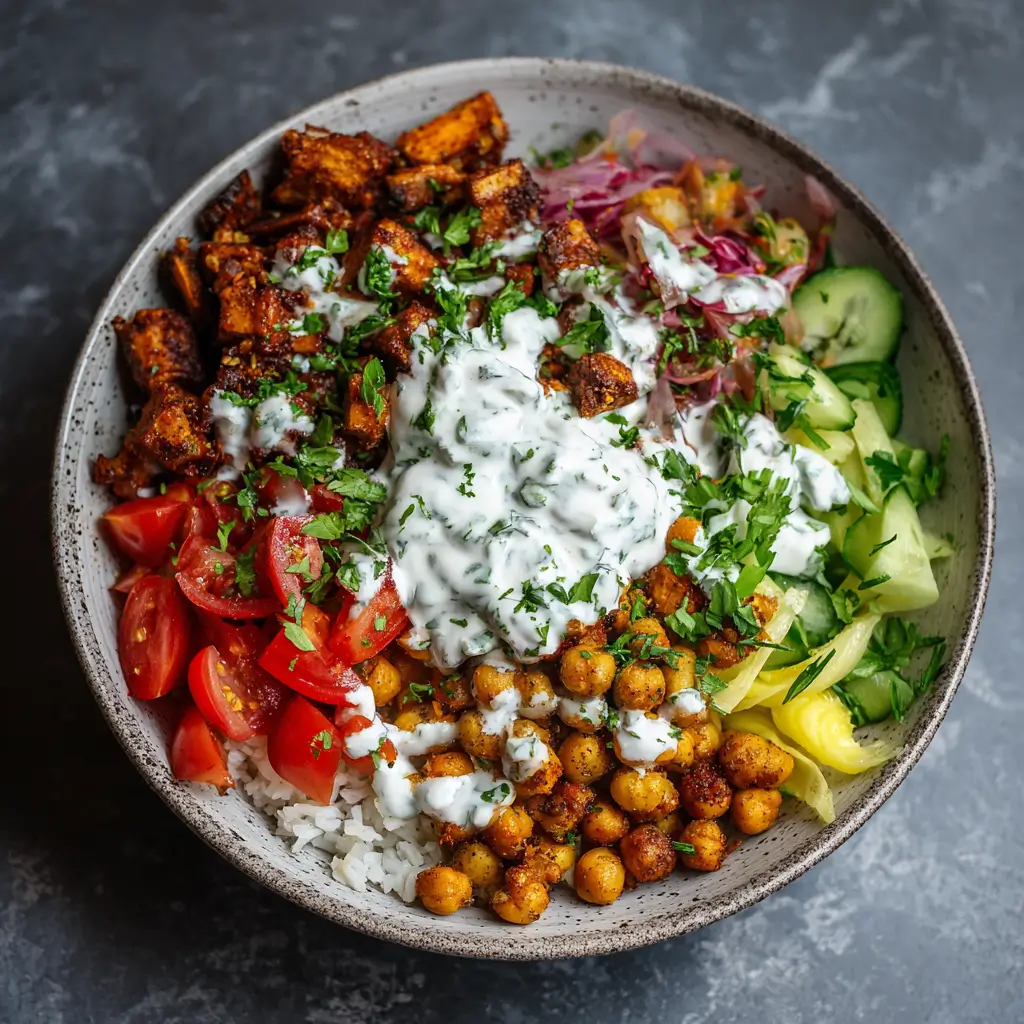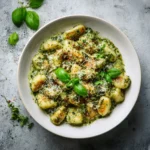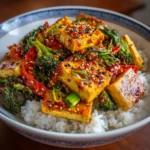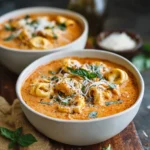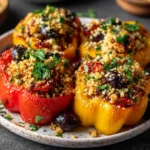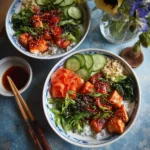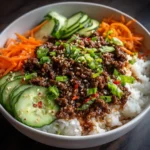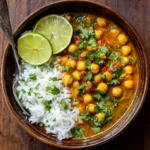Introduction
The Vegetarian Chickpea Shawarma Bowl is a vibrant, flavorful, and nutritious dish that brings the bold spices of Middle Eastern cuisine into a modern, plant-based format. Perfect for health-conscious food lovers, meal preppers, or anyone seeking a satisfying meat-free alternative to traditional shawarma, this bowl combines protein-rich chickpeas with aromatic spices, fresh vegetables, creamy sauces, and wholesome grains. Whether you’re a seasoned vegetarian or simply exploring more plant-forward meals, this recipe offers a delicious way to enjoy complex flavors without sacrificing nutrition or satisfaction.
The History
Shawarma, a beloved street food across the Middle East, originated from the Ottoman Empire’s vertical rotisserie-cooked meats, influenced by Turkish döner kebab and Greek gyros. Traditionally made with lamb, chicken, or beef stacked on a spit and slowly roasted, shawarma has become a global favorite known for its tender texture and rich blend of spices like cumin, coriander, turmeric, and cinnamon. As plant-based diets have surged in popularity, creative adaptations have emerged—leading to vegetarian and vegan versions that maintain the essence of the original. The Vegetarian Chickpea Shawarma Bowl is one such innovation, replacing meat with spiced, roasted chickpeas. This transformation not only makes the dish accessible to vegetarians and vegans but also aligns with sustainable eating practices while preserving the deep, savory flavor profile that defines authentic shawarma.
Ingredients Breakdown
The magic of the Vegetarian Chickpea Shawarma Bowl lies in its harmonious layering of ingredients, each contributing distinct textures, nutrients, and flavors. Here’s a detailed breakdown:
- Chickpeas: The star ingredient, packed with plant-based protein, fiber, iron, and folate. Canned chickpeas offer convenience, but dried ones (soaked and cooked) can be used for a fresher taste.
- Olive Oil: Used to coat the chickpeas before roasting, it helps crisp the exterior and carry the spices evenly. Extra virgin olive oil adds a fruity depth.
- Shawarma Spice Blend: A fragrant mix typically including paprika, cumin, coriander, garlic powder, onion powder, turmeric, cinnamon, and cayenne. These spices provide warmth, earthiness, and a hint of heat.
- Lemon Juice: Adds brightness and balances the richness of the spices. Freshly squeezed juice is always best for maximum flavor.
- Garlic: Fresh minced garlic enhances the savory depth and pairs beautifully with the spice blend.
- Base Grains: Options include brown rice, quinoa, farro, or couscous. Quinoa is especially popular for its complete protein content and fluffy texture.
- Fresh Vegetables: Chopped cucumber, cherry tomatoes, red onion, shredded lettuce, and parsley add crunch, color, and freshness.
- Tahini Sauce: A creamy emulsion of tahini (sesame paste), lemon juice, garlic, water, and salt. It’s nutty, tangy, and rich—a perfect complement to the spiced chickpeas.
- Pickled Red Onions or Turnips: Optional but recommended for a zesty, tangy kick that cuts through the richness.
- Lettuce or Greens: Butter lettuce, romaine, or baby spinach form a crisp base layer.
- Optional Toppings: Crumbled feta (omit for vegan), olives, roasted red peppers, avocado slices, hummus, or sumac-dusted onions.
Step-by-Step Recipe
- Preheat the Oven: Set your oven to 400°F (200°C). Line a large baking sheet with parchment paper for easy cleanup.
- Prepare the Chickpeas: Drain and rinse 2 cans (15 oz each) of chickpeas. Pat them dry thoroughly with a clean kitchen towel or paper towels—this step is crucial for achieving crispiness.
- Season the Chickpeas: In a large bowl, combine the chickpeas with 3 tablespoons of olive oil, 1 tablespoon lemon juice, 3 minced garlic cloves, 1 teaspoon smoked paprika, 1 teaspoon ground cumin, 1 teaspoon ground coriander, ½ teaspoon garlic powder, ½ teaspoon onion powder, ¼ teaspoon turmeric, ¼ teaspoon cinnamon, ¼ teaspoon cayenne pepper (adjust to taste), and salt to taste. Toss until evenly coated.
- Roast the Chickpeas: Spread the seasoned chickpeas in a single layer on the prepared baking sheet. Roast for 25–30 minutes, flipping halfway through, until golden brown and crispy on the outside. For extra crispness, broil for 2–3 minutes at the end, watching closely to avoid burning.
- Cook the Base Grain: While the chickpeas roast, prepare 1 cup of quinoa or rice according to package instructions. Use vegetable broth instead of water for added flavor. Let it cool slightly.
- Prepare the Tahini Sauce: In a small bowl, whisk together ⅓ cup tahini, 3 tablespoons lemon juice, 1 minced garlic clove, 2–4 tablespoons water (until smooth and pourable), and a pinch of salt. Adjust consistency and seasoning to taste.
- Chop the Vegetables: Dice 1 cucumber, halve 1 cup cherry tomatoes, thinly slice ½ red onion, and chop a handful of fresh parsley. You can also add shredded lettuce or baby spinach.
- Assemble the Bowls: In each serving bowl, start with a base of warm grain. Add a generous portion of roasted chickpeas, followed by layers of chopped vegetables. Drizzle generously with tahini sauce and sprinkle with optional toppings like pickled onions, feta, or avocado.
- Serve Immediately: Enjoy hot or at room temperature. The contrast of warm chickpeas with cool veggies and creamy sauce is part of the dish’s appeal.
Tips
- Dry Chickpeas Well: Moisture is the enemy of crispiness. Take time to pat the chickpeas completely dry before seasoning.
- Don’t Crowd the Pan: Spread chickpeas in a single layer with space between them to ensure even roasting and browning.
- Bulk Up the Spices: For deeper flavor, toast whole spices (cumin seeds, coriander seeds) before grinding them yourself.
- Make Ahead Components: Roast chickpeas and cook grains up to 3 days in advance. Store separately in airtight containers. Reheat chickpeas in the oven to restore crispness.
- Customize the Heat: Adjust cayenne or add harissa paste for more spice, or omit for a milder version.
- Boost Creaminess: Stir a spoonful of Greek yogurt into the tahini sauce for a richer texture (or use dairy-free yogurt for vegan option).
- Add Acid: A final squeeze of lemon juice just before serving brightens all the flavors.
- Use Colorful Veggies: Include bell peppers, radishes, or shredded purple cabbage for visual appeal and added nutrients.
Variations and Customizations
This bowl is highly adaptable to personal preferences, dietary needs, and seasonal ingredients:
- Protein Swaps: Replace chickpeas with spiced lentils, grilled tofu, tempeh, or seitan for different textures.
- Grain-Free Option: Serve over cauliflower rice or a bed of mixed greens for a low-carb version.
- Mediterranean Twist: Add kalamata olives, artichoke hearts, and sun-dried tomatoes for a Greek-inspired flair.
- Spice Variations: Try a Baharat blend or add cardamom and cloves for a more complex profile.
- Gluten-Free: Ensure all ingredients (especially spice blends and grains) are certified gluten-free if needed.
- Vegan Ranch: Swap tahini sauce for a cashew-based ranch or tzatziki made with dairy-free yogurt.
- Meal Prep Friendly: Prepare components in bulk and assemble bowls throughout the week. Keep sauces separate until ready to eat.
- Kid-Friendly Version: Reduce spices, serve with mild hummus, and include sweet elements like roasted carrots or corn.
Health Considerations and Nutritional Value
The Vegetarian Chickpea Shawarma Bowl is a powerhouse of nutrition, offering a balanced mix of macronutrients and essential micronutrients:
- High in Plant Protein: Chickpeas provide about 15g of protein per cup, supporting muscle repair and satiety.
- Rich in Fiber: With over 12g of fiber per serving, this bowl promotes digestive health and helps regulate blood sugar levels.
- Heart-Healthy Fats: Olive oil and tahini contribute monounsaturated fats, which support cardiovascular health.
- Low Glycemic Index: Whole grains and legumes release energy slowly, preventing spikes in blood sugar.
- Vitamins and Minerals: Packed with vitamin C (from lemon and veggies), iron (chickpeas), folate, magnesium, and antioxidants from colorful produce.
- Anti-Inflammatory Properties: Turmeric and garlic contain compounds like curcumin and allicin, known for their anti-inflammatory benefits.
- Dietary Flexibility: Naturally vegan (if feta is omitted), gluten-free (with proper grain choice), and free from refined sugars.
- Portion Control: Easy to customize portion sizes for weight management goals.
One serving (without excessive oil or high-calorie toppings) typically ranges between 450–600 calories, depending on ingredient proportions.
Ingredients
- 2 (15 oz) cans chickpeas, drained, rinsed, and patted dry
- 3 tbsp olive oil
- 1 tbsp lemon juice (freshly squeezed)
- 3 cloves garlic, minced
- 1 tsp smoked paprika
- 1 tsp ground cumin
- 1 tsp ground coriander
- ½ tsp garlic powder
- ½ tsp onion powder
- ¼ tsp ground turmeric
- ¼ tsp ground cinnamon
- ¼ tsp cayenne pepper (optional)
- Salt to taste
- 1 cup quinoa or brown rice (uncooked)
- 2 cups water or vegetable broth
- 1 cucumber, diced
- 1 cup cherry tomatoes, halved
- ½ red onion, thinly sliced
- ¼ cup fresh parsley, chopped
- 2 cups shredded lettuce or baby spinach
- ⅓ cup tahini
- 3 tbsp lemon juice (for sauce)
- 1 clove garlic, minced (for sauce)
- 2–4 tbsp water (for sauce)
- Optional: crumbled feta, pickled red onions, avocado slices, olives
Directions
- Preheat oven to 400°F (200°C). Line a baking sheet with parchment paper.
- In a large bowl, combine chickpeas, olive oil, lemon juice, minced garlic, and all spices. Toss until chickpeas are evenly coated.
- Spread chickpeas in a single layer on the baking sheet. Roast for 25–30 minutes, flipping halfway, until crispy and golden. Broil 2–3 minutes for extra crunch if desired.
- While chickpeas roast, cook quinoa or rice in water or vegetable broth according to package directions. Fluff and set aside.
- Prepare tahini sauce: Whisk tahini, lemon juice, garlic, water, and salt until smooth. Add water gradually to reach a drizzling consistency.
- Chop all vegetables and herbs.
- To assemble: Divide grains among 4 bowls. Top with roasted chickpeas, cucumber, tomatoes, red onion, parsley, and greens.
- Drizzle with tahini sauce and add any optional toppings.
- Serve immediately, optionally with warm pita bread or flatbread on the side.
FAQ
Can I make this recipe ahead of time?
Yes! Roast the chickpeas and cook the grains up to 3 days in advance. Store them separately in the fridge. Reheat chickpeas in the oven to restore crispiness. Chop vegetables and make sauce 1–2 days ahead and keep refrigerated.
How do I store leftovers?
Store components separately in airtight containers in the refrigerator for up to 4 days. Reheat chickpeas and grains before assembling. Add sauce and fresh veggies when serving.
Can I freeze the roasted chickpeas?
Yes, though they may lose some crispness. Freeze in a single layer on a tray, then transfer to a freezer bag for up to 3 months. Reheat in the oven to refresh.
Is this recipe gluten-free?
Yes, as long as you use gluten-free grains like quinoa or certified gluten-free oats/couscous, and ensure your spice blend is gluten-free.
What can I use instead of tahini?
You can substitute with almond butter, cashew butter, or sunflower seed butter for a similar creamy texture, though the flavor will vary slightly.
Are canned chickpeas healthy?
Yes, canned chickpeas are nutritious and convenient. Rinse them well to reduce sodium content. Low-sodium options are available.
Can I air-fry the chickpeas?
Absolutely! Air-fry at 380°F (190°C) for 15–20 minutes, shaking the basket every 5 minutes, until crispy.
How can I make this kid-friendly?
Reduce the spices, serve with mild hummus, and let kids build their own bowls with fun toppings like corn, cheese, and diced avocado.
Summary
The Vegetarian Chickpea Shawarma Bowl is a vibrant, nutrient-dense meal that captures the bold flavors of Middle Eastern cuisine in a wholesome, plant-based format. Packed with protein, fiber, and colorful vegetables, it’s as nourishing as it is delicious—perfect for busy weeknights, meal prep, or impressing guests with minimal effort.
